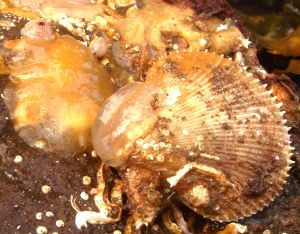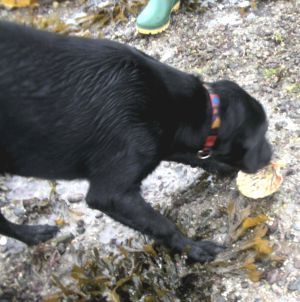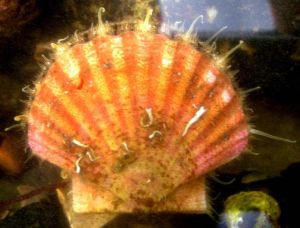|
(I started keeping a blog on the Internet in March 2009, converted to the paperless medium of an electronic travelling journal by my daughter, on time-saving grounds. In practice it takes up rather more of my time.........but I enjoy writing it) I’m on my way to the Western Isles, sharing a car with two fellow conchologists. It is the annual field meeting and I am returning to an island I have visited seldom. Nick and I first went to Skye in 1982 shortly after I became a member of the Conchological Society. It was a wonderful trip in many ways, my first experience of serious, enlightened, engaging conchology. From the A1 we shift to the A66 and cross England from east to west. Then we are in the Lake District with the sun on its gently rolling hills and mountains, cosying up to each other and where they meet and fold into valleys they remind me of great sleeping Labrador puppies. The geology of the Lake District is a story of colliding continents, an event which melded two very different terrains. The ancient rocks of the north are bound to the younger lithologies of the south: the geology of the British Isles spans an unimaginable length of deep time……….. ................. much later we are driving through such wilderness as the British Isles have to offer. High hills and mountains, some forested, some barren and lower slopes golden with grasses and sedges on the turn and hazily purple with the heathers. There are familiar signposts along the way, Onich, Invergarry and on the very final stretch we come to Dornie with its famous castle. With the sun moving to the west the light casts our aspect of the castle into shade, its brooding presence tricky to photograph. When we arrive at the house we are to share with four others, they are out walking but return soon after we pull up the drive There is a lamb stew on the stove and when we sit down for supper the seven of us get to know each other, there’s lots of banter and we sort out housekeeping arrangements. The field meeting proper does not start until Friday. So on Thursday we sally forth to a shore we checked out the evening before when the tide was in and there weren’t many shells lying around. The only clue we have is that offshore islets and the general aspect of the shore mean it is very sheltered and marine invertebrates like that. The tide is well on the ebb when we arrive. There is a small cascading burn which is flowing under a bridge and down onto the foreshore. This means it would be unsafe to eat any gleanings from this particular beach. There are the usual cockles, mussels and winkles to be found, also a few oysters. As the tide goes down we wade in the still, clear shallow water, finding boulders to roll and underneath, beauties including the lovely snow scallop (Chlamys nivea) attached to the boulder by its byssus. It is sitting alongside living Trivia and a sea slug Berthella plumula, which when dark orange, looks just like half an apricot. We take numerous photos of these animals in situ and roll the rock back into position (see above. Photo: Bas Payne). Before the tide turns we have taken weeds to wash and have scrubbed boulders to sample all the microscopic species we’ll never spot with the naked eye. Sorting these sieved residues later reveals a fascinating array of tiny snails including a trio of species which look like minute whelks (less than 2mm high) with purple-ringed apertures. These are segregates of the lovely Rissoa lilacina. We take all our samples away in bags and pots and then sit on the grassy bank watching the tide flow towards us and eat sandwiches, fruit and Kit Kats. We return to the house. It is my turn to cook our supper so I produce ‘Christine Street’s’ curry which was such a hit on the Anglesey meeting. The following day at Camus Croise we are entertained by Seb the 6-month old Labrador pup who has a fine time finding shells and tossing them about in the hope that someone will play with him. Despite the weather we complete our tasks and as we haul our wet selves back to the car I am already looking forward to the get-together we have planned for the whole group at our house in Kyleakin. We are a bumper 17 on this field trip ranging from experts to novices, dab hands and newer members. We are going to start at 6 o’clock in order to cater for people with long journeys to their guesthouses. Because of Skye’s shape, journeys across the island can easily take 2 hours. We are keeping the meal ever so simple so its bangers and mash with green beans and I am in charge of making the largest pan of fried onions I’ve ever cooked but Rosemary and Sonia are chefs for the evening. Afterwards we serve apple pie, ice cream and cream. After the last guests have gone I stay at my microscope for a short while but I am already behind with my samples. And tomorrow’s shore is the biggie! On the day of the very lowest springs, when you really have a sense of tiptoeing over the seabed, we go to a wonderful shore just west of Broadford Bay near Strollamus. It is a particularly unbeautiful beach, more or less level, featureless and very brown. The cobbles, pebbles, gravels, the brown fucoid seaweeds: all give an impression of a dull, shadowy place. But what marvels it reveals once you start to look. The site is at a point where, at extreme low water, the channel between the shore and the opposing shore on the island of Scalpay is at its narrowest. When the tide is running through narrows you get a rapids effect and lots of marine life seems to like that. Sponges can be prolific and scallops obviously benefit from a constant stream of particulate matter to filter feed on. Perhaps that is why I find lots of juvenile scallops: the king, Pecten maximus, the queen Aequipecten opercularis and the dainty snow scallop, Chlamys nivea. Individuals of the former two species are bright splashes of colour at the water’s edge or seen through the shallows amongst the gravels and weeds. The ‘nivea’ tend to attach to the undersides of large cobbles and rocks. I saw lots of baby ‘kings’: it’s a veritable nursery. I know from what I learnt on my first trip to Skye 27 years ago that local scallop divers used to pick up juveniles and move them around to ‘nursery’ grounds of their choosing. This simple management of their local resource made it easier for them to exploit the scallops in a sustainable way. In addition to an array of molluscs, including interesting clam species which we sieve from the gravels, there are lots of sea urchins. There are many of the small Psammechinus miliaris urchins under rocks, but there are also large individuals of Echinus esculentus amongst the kelp plants in the shallows. These are edible but I have never tried them. The taste of urchin is said to taste like nothing else – an article in the Independent ,which I found on the internet, described them as having a creamy taste with a hint of iodine. Peter finds a perfect test of the purple heart urchin, Spatangus purpureus which he later bleaches clean. It is a prize. We take our usual weeds to wash, and scrub boulders on the shore. Just before we leave, Steve picks up a large paired Pecten shell. It has several interesting specimens on and inside it. We can see the turrid, the nudibranch, the chiton, the limpet and the young scallop attached to the exterior, and the interior has some small clods of sediment. We decide to take it back and see how many species we retrieve from it as a sample of ’substrate’. When every last bit of sieved mud has been picked through we have a tally of more than 30 mollusc species from this single object. As things turn out our tide on Strollamus turns out to be my seashore highlight. With deteriorating weather, time on the beach becomes more of a challenge and I adopt my supermarket approach to fieldwork. You just have to rush in, fill your trolley (buckets) with what you need and dash out again. The luxury of wandering over the shore looking for shells lying around, or lifting rocks to peer underneath is nothing like so enjoyable when you have rain dripping off the hood of your jacket onto your nose, and you have no windscreen-wipers on your spectacles. Nevertheless on the last shore day I learn a new trick. Julia is well versed in the finding and identifying of nudibranchs, otherwise known as sea-slugs. Some of them are so minute you barely see them with a naked eye, but you can know where to look and in the matter of Doto, Julia does…………... (see page 19 of this issue.) At the end of the meeting, three of us set out on Tuesday morning for our journey south. The weather is still moist and overcast but we are blessed with a wonderful rainbow on our way to Fort William. We are all quiet and, I guess, wrapped up in many thoughts. I am thinking about the sample pots I am taking home. During our sorting sessions one of my compatriots looked through his microscope and uttered an expletive. I peered down his eyepieces and saw that he had a point. His petri dish was awash with small snails. There were hardly any mineral grains or other beings. He looked at his pot of residue and saw that it was uniformly the same. We did a finger in the air calculation and worked out that his pot might contain 64,000 snails. Fortunately they were nearly all specimens of less than a handful of species. But the sample needs to be sorted, and species identified, because this is why we take samples of the weed faunas. These are tiny molluscs, we are talking a pot the size of a plastic 35mm-film canister. That’s just one sample and we have looked at 6 sites. As we drive along I look out at the mountains on this misty morn and sigh. So many snails……….. so little time. |
Rissoa lilacina rufilabrum Port an Eorna (Photo: Peter Topley)
Seb "shell collecting" at Camus Croise (Photo: Peter Topley)
Juvenile Pecten maximus, Strollamus (Photo: Peter Topley)
Sieving gravel for molluscs, Strollamus (Photo: Peter Topley) Images |
Skye ConchLog: excerpts from a Conchologist’s Blog
Issue
22
Page
7





